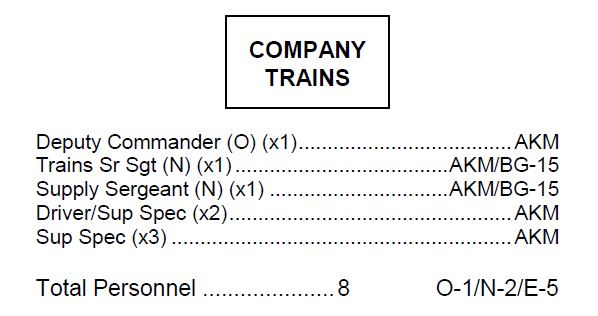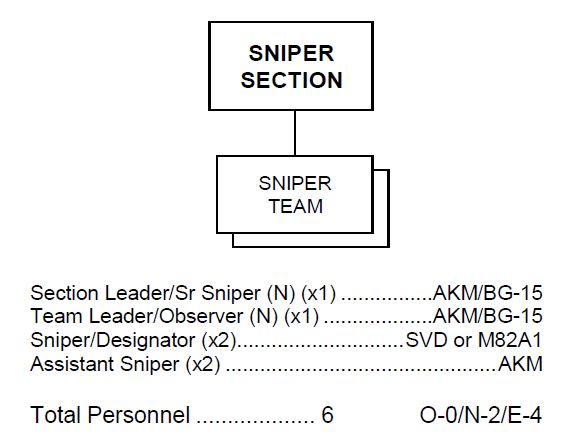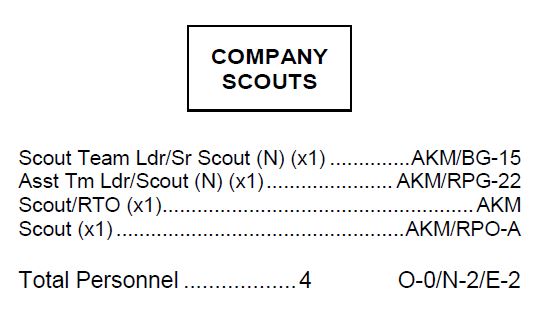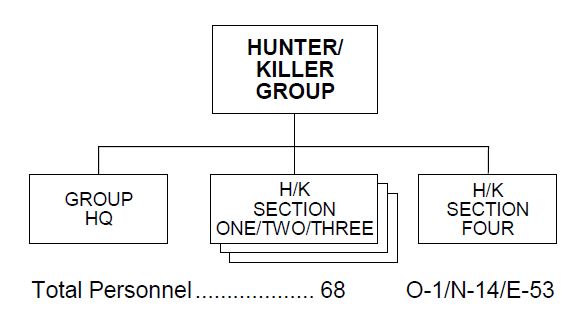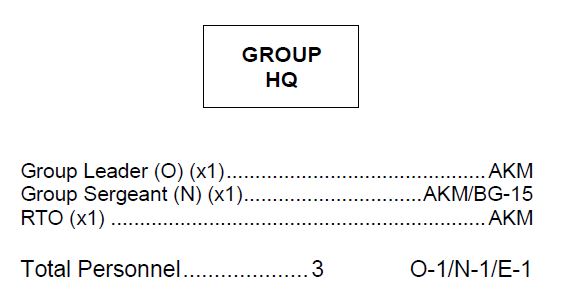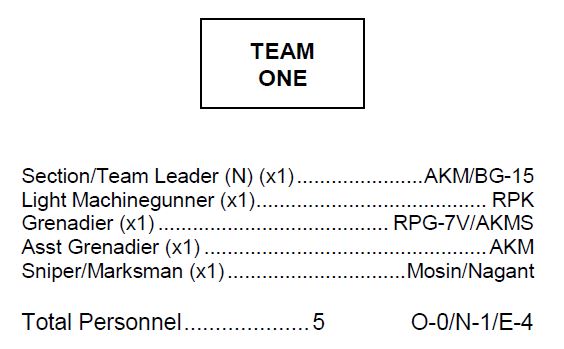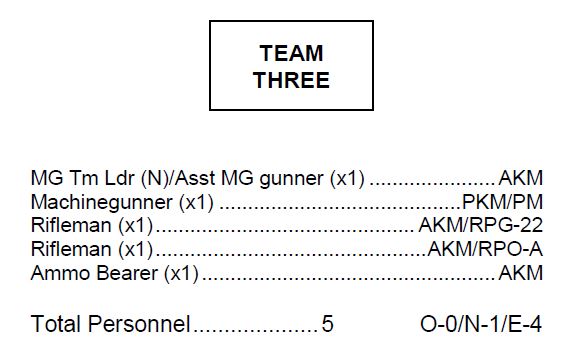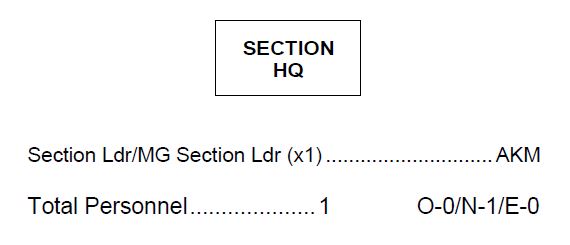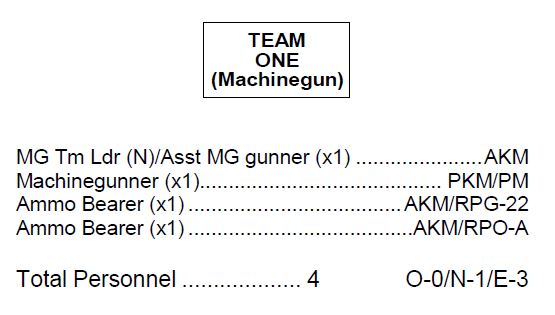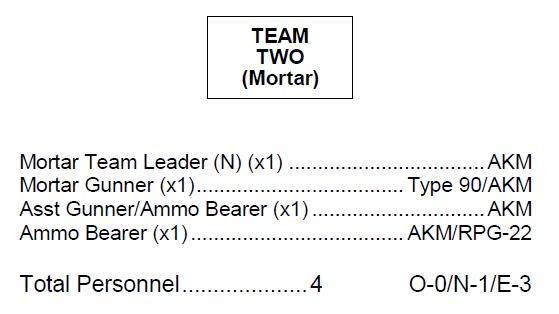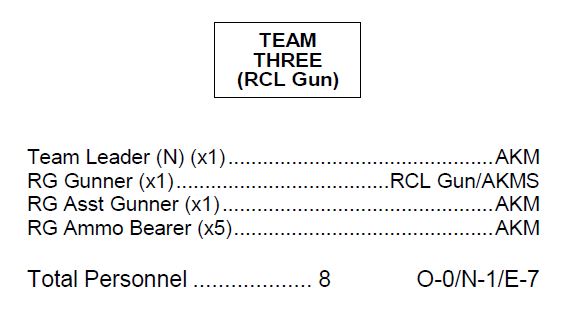Appendix E: Guerrilla Hunter/Killer Company from the HTFS Organizational Directories
- This page is a section of TC 7-100.4 Hybrid Threat Force Structure Organization Guide.
This appendix provides an example of the information for a guerrilla hunter/killer company and its subordinates, as found in the Hybrid Threat Force Structure (HTFS) organizational directories under the guerrilla battalion. It also includes the spreadsheets for the personnel and equipment in the guerrilla hunter/killer company and for the guerrilla battalion as a whole.
- Note. For illustrative purposes, this TC contains several examples from the online HTFS organizational directories. Readers are reminded that even the baseline OPFOR organizations are subject to change over time. Therefore, readers should always consult the online directories for the latest, most up-to-date versions of organizational data.
Contents
- 1 Guerrilla Organizations
- 1.1 Guerrilla Hunter/Killer Company Example
- 1.1.1 Guerrilla Hunter/Killer Company, Guerrilla Battalion
- 1.1.2 Headquarters and Command Section, Hunter/Killer Company
- 1.1.3 Command Team, Hq & Cmd Section, Hunter/Killer Company
- 1.1.4 Company Trains, Hq & Cmd Section
- 1.1.5 Sniper Section, Hq & Cmd Section
- 1.1.6 Company Scouts, Hq & Cmd Section
- 1.1.7 Hunter/Killer Group, Guer H/K Company
- 1.1.8 Group Headquarters, Guerrilla H/K Company
- 1.1.9 Hunter/Killer Sections One, Two, Three, H/K Group One & Two
- 1.1.10 H/K Team One, Sections One, Two, Three
- 1.1.11 H/K Team Two, Sections One, Two, Three
- 1.1.12 H/K Team Three, Sections One, Two, Three
- 1.1.13 Hunter/Killer Section Four, H/K Group
- 1.1.14 Section Headquarters, Hunter/Killer Section Four
- 1.1.15 Team One (Machinegun), Hunter/Killer Section Four
- 1.1.16 Team Two (Mortar), Hunter/Killer Section Four
- 1.1.17 Team Three (RCL Gun), Hunter/Killer Section Four
- 1.1.18 Guerrilla Battalion Personnel and Equipment
- 1.1 Guerrilla Hunter/Killer Company Example
Guerrilla Organizations
Guerrilla organizations come in various shapes and sizes. They may be as large as several brigades or as small as a platoon and/or independent hunter/killer (H/K) teams. The structure of the organization depends on several factors including the physical environment, sociological demographics and relationships, economics, and support available from external organizations and countries. In any case, a guerrilla organization might be affiliated with forces from other countries or external organizations.
The composition of the guerrilla brigade may vary. A basically rural, mountainous, or forested area with no major population centers might have a guerrilla brigade with only one or two battalions (or five or six companies) with little or no additional combat support or combat service support. A guerrilla brigade operating astride a major avenue of approach, or one that contains several major population (urban) or industrial centers, might be a full guerrilla brigade with additional combat support or combat service support elements.
Often a brigade-sized guerrilla force may not be appropriate—a guerrilla battalion or a task-organized battalion may be sufficient. A typical task-organized-battalion might have four or five guerrilla H/K companies, organic battalion units, and a weapons battery from brigade (with mortar, antitank, and rocket launcher platoons) and possibly IEW support.
Guerrilla Hunter/Killer Company Example
The guerrilla H/K company is simply a restructured guerrilla company. Therefore, they both contain the same number of personnel and similar numbers of equipment. The guerrilla company fights unconventionally with platoons, squads, and fire teams. When organized for combat as a guerrilla H/K company, it also fights unconventionally, but with H/K groups, sections, and teams. The task-organized, lethal H/K team structure is ideal for dispersed combat such as fighting in built-up areas, especially urban combat. Complete battalions and brigades—or any part thereof—can be organized for combat as H/K units.
A guerrilla battalion may be any combination of guerrilla companies or guerrilla H/K companies. When a battalion consists predominantly of guerrilla H/K companies, it may be considered a guerrilla H/K battalion. The guerrilla H/K company/battalion is especially effective and lethal in close environments (such as urban, forest, or swamp). The structure that makes H/K teams virtually impossible to isolate and kill in a dispersed fight also allows them to melt into the population and terrain whenever necessary.
Guerrilla Hunter/Killer Company, Guerrilla Battalion
NOTES:
- The guerrilla company can be organized for combat into a “guerrilla hunter/killer (H/K) company.” Guerrilla company assets are augmented and restructured for combat into task organized lethal H/K teams. The H/K team structure is ideal for dispersed combat such as fighting in built-up areas, especially urban combat. Complete battalions and brigades can be organized for combat as H/K units. The guerrilla H/K company is broken into three H/K groups. Each group has four sections of three infantry H/K teams each. The company contains a total of 36 H/K teams—39 H/K teams if the two sniper teams and the company scouts are counted.
- The guerrilla H/K company has sufficient assets to transport munitions and materiel for the immediate fight. The two organic trucks (one light, one medium) provide the company a degree of operational autonomy from the battalion. The area of responsibility for guerrilla units may be fairly large. The company is dependent upon support from higher (i.e., battalion transport platoon), or external sources to transport materiel, (caches, civilian augmentation), for a sustained fight.
- Vehicles may be a mix of military and civilian. The guerrilla company may be augmented by military or civilian vehicles (motorcycles, trucks, cars, bicycles, carts, or high-mobility/all terrain vehicles) or personnel depending on the mission. Local sympathizers may volunteer their equipment and services. The commander may requisition or confiscate local civilian transportation assets and materiel. This includes the use of noncombatant personnel to serve as porters. The guerrillas may have no vehicles at all and depend on caches, porters, or other transportation means.
- The guerrillas may, or may not, be in uniform. They may wear civilian clothing and be indistinguishable from the local population (other than weaponry which they may conceal or discard). Some, or all, may be “part-time” soldiers and melt into the general populace when not assembled to conduct paramilitary operations.
NOTE: The guerrilla hunter/killer company is simply a restructured guerrilla company. Therefore, they both contain the same number of personnel and similar numbers of equipment (see footnotes **/*** below).
- * With II night sight.
- ** The H/K company may have three additional three 60-mm Commando Mortars, M70 (for a total of six), distributed to H/K Team Two in Section One for each H/K group. Additional personnel are not required.
- *** Although based on personnel and equipment numbers of the guerrilla company, the H/K company has additional equipment due to the dispersed nature of H/K team employment. RPG-22 (+7), RPO-A (+4).
- **** Includes bangalore torpedoes, shaped charges, AT grenades, other tactical demolitions.
- ***** Includes remotely detonated mines, IEDs, booby traps, and side-attack (AT & anti-vehicle) mines. The mix is mission dependent and varies.
- Note. See next chart for listing of personnel and equipment of the guerrilla hunter/killer company in spreadsheet format, broken down by subordinate organizations.
Headquarters and Command Section, Hunter/Killer Company
NOTE: The headquarters and command section may be augmented by additional military and civilian vehicles, trucks, bicycles, carts, tactical utility vehicles (TUVs), motorcycles, or high-mobility/all-terrain vehicles, etc., depending on the mission. The headquarters and command section may have no vehicles at all and depend on caches, porters, or other transportation and resupply means.
- * With II night sight.
- ** Issued as ammunition rather than a weapon—the BOI may vary. No dedicated operator.
- *** Includes bangalore torpedoes, shaped charges, AT grenades, other tactical demolitions.
- **** Includes remotely detonated mines, IEDs, booby traps, and side-attack (AT & anti-vehicle) mines. The mix is mission dependent and varies.
Command Team, Hq & Cmd Section, Hunter/Killer Company
NOTES:
- The command team locates forward with H/K company.
- The former weapons platoon leader now performs as a “deputy commander for tactics.”
- * Issued as ammunition rather than a weapon—the BOI may vary.
Company Trains, Hq & Cmd Section
NOTES:
- The deputy commander is in charge of the company trains.
- Two vehicle-mounted 12.7-mm HMGs assist in the security of the company trains and in an AA role. They may be brought forward with tripod mounts to assist in the battle.
- The former weapons platoon sergeant now serves as the trains’ senior sergeant.
- Some local sympathizers may volunteer their equipment and services. The commander may requisition or confiscate local civilian transportation assets. Noncombatant personnel or draft animals may be used as bearers/porters. May be augmented by military or civilian vehicles (motorcycles, trucks, cars, bicycles, carts, or high-mobility/all terrain vehicles) or personnel.
- Corner-mounted mechanical hoists are used to load and unload the two trucks.
- * With II night sight.
- ** A 12.7-mm HMG is mounted on both trucks. Whoever is not driving operates the vehicle HMG. A tripod mount is also carried for the ground support role.
- *** Issued as ammunition rather than a weapon—the BOI may vary. No dedicated operator.
- **** Includes bangalore torpedoes, shaped charges, AT grenades, other tactical demolitions.
- ***** Includes remotely detonated mines, IEDs, booby traps, and side-attack (AT & anti-vehicle) mines. The mix is mission dependent and varies.
Sniper Section, Hq & Cmd Section
NOTES:
- The sniper section consists of two sniper teams. The section leader serves as the team leader of one sniper team. Each sniper team consists of a team leader/observer (spotter) a sniper (shooter)/ target designator and an assistant sniper. The assistant sniper provides additional security, transports equipment, and may serve as a sniper/observer backup.
- The sniper carries either a 7.62-mm or .50-cal sniper rifle depending on the mission. The other rifle is carried by the assistant sniper until needed.
- The primary mission of the sniper section is to serve in the conventional sniper-countersniper role. Depending on mission requirements however the sniper team may also serve as a reconnaissance element, a stay-behind element, or as part of a hunter/killer team.
- The sniper section may be augmented by available military or civilian vehicles (cars, trucks, motorcycles, carts, bicycles, or high-mobility/all terrain vehicles) depending on the mission.
- * With II night sight.
Company Scouts, Hq & Cmd Section
NOTES:
- The scout team leader/senior scout is the former recoilless gun section leader. The assistant team leader is the former machinegun section leader. The RTO/Scout is the former RTO for the weapons platoon, and the remaining scout is a former supply specialist with the HQ &Svc Section.
- Transportation when required will be provided by either the TUVs from the command team or the trucks from the trains.
- * Issued as ammunition rather than a weapon—the BOI may vary. No dedicated operator.
- ** Includes remotely detonated mines, IEDs, booby traps, and side-attack (AT & anti-vehicle) mines.
- *** With II night sight.
Hunter/Killer Group, Guer H/K Company
NOTES:
- The H/K groups are identical, as are Sections One, Two, and Three of the groups. Section Four is organized differently.
- Local sympathizers may volunteer their equipment and services. The commander may requisition or confiscate local civilian transportation assets. Noncombatant personnel or draft animals may be used as bearers/porters. Ammunition and assorted mines are distributed (cross-leveled) amongst members of the group.
- The guerrilla H/K group may be augmented by military or civilian vehicles (motorcycles, trucks, cars, bicycles, carts, or high-mobility/all-terrain vehicles) or personnel depending on the mission.
- One of the guerrillas is cross-trained as a medic.
- * With II night sight.
- ** Issued as ammunition rather than a weapon—the BOI may vary. No dedicated operator.
- *** Includes bangalore torpedoes, shaped charges, AT grenades, other tactical demolitions.
- ***** Includes remotely detonated mines, IEDs, booby traps, and side-attack (AT & anti-vehicle) mines. The mix is mission dependent and varies.
Group Headquarters, Guerrilla H/K Company
- * With II night sight.
Hunter/Killer Sections One, Two, Three, H/K Group One & Two
NOTES:
- H/K Sections One, Two, and Three are identical. The subordinate teams (One, Two, and Three) differ.
- Some teams may have a 7.62-mm GP MG, PKM in lieu of a 7.62-mm LMG, RPK (mission dependent). Equipment may be transferred between H/K sections and teams.
- Depending on the tactical circumstances, some sections/teams may have additional ammo bearers. Noncombatant personnel or draft animals may also be used as bearers/porters.
- * With II night sight.
- ** Issued as ammunition rather than a weapon—the BOI may vary. No dedicated operator.
- *** Includes bangalore torpedoes, shaped charges, AT grenades, other tactical demolitions.
- **** Includes remotely detonated mines, IEDs, booby traps, and side-attack (AT & anti-vehicle) mines. The mix is mission dependent and varies.
H/K Team One, Sections One, Two, Three
NOTE: The team leader also serves as the section leader.
- * Issued as ammunition rather than a weapon—the BOI may vary. No dedicated operator.
- ** Includes bangalore torpedoes, shaped charges, AT grenades, other tactical demolitions.
- *** Includes remotely detonated mines, IEDs, booby traps, and side-attack (AT & anti-vehicle) mines. The mix is mission dependent and varies.
H/K Team Two, Sections One, Two, Three
- * Issued as ammunition rather than a weapon—the BOI may vary. No dedicated operator.
- ** Includes bangalore torpedoes, shaped charges, AT grenades, other tactical demolitions.
- *** Includes remotely detonated mines, IEDs, booby traps, and side-attack (AT & anti-vehicle) mines. The mix is mission dependent and varies.
H/K Team Three, Sections One, Two, Three
- * With II night sight.
- ** Issued as ammunition rather than a weapon—the BOI may vary. No dedicated operator.
- *** Includes bangalore torpedoes, shaped charges, AT grenades, other tactical demolitions.
- **** Includes remotely detonated mines, IEDs, booby traps, and side-attack (AT & anti-vehicle) mines. The mix is mission dependent and varies.
Hunter/Killer Section Four, H/K Group
NOTES:
- Section Four is constructed using augmentation from the company weapons platoon. It is augmented with one (of three) 7.62-mm GP MG, PKMs; one (of three) Type 90, 60-mm mortars; and one (of three) 82-mm Type 65-1 recoilless guns from the company weapons platoon.
- The teams may receive additional transportation support from the headquarters and command section.
- Ammunition is also distributed amongst members of the company. Some teams may have additional ammo bearers. Noncombatant personnel or draft animals may also be used as bearers/porters.
- * With II night sight.
- ** Issued as ammunition rather than a weapon—the BOI may vary. No dedicated operator.
- *** Includes bangalore torpedoes, shaped charges, AT grenades, other tactical demolitions.
- **** Includes remotely detonated mines, IEDs, booby traps, and side-attack (AT & anti-vehicle) mines. The mix is mission dependent and varies.
Section Headquarters, Hunter/Killer Section Four
NOTE: The section leader was formerly the MG section leader for the platoon MG section.
- * With II night sight.
Team One (Machinegun), Hunter/Killer Section Four
NOTE: This team was formerly in the machinegun section, company weapons platoon.
- * With II night sight.
- ** Issued as ammunition rather than a weapon—the BOI may vary. No dedicated operator.
- *** Includes remotely detonated mines, IEDs, booby traps, and side-attack (AT & anti-vehicle) mines.
Team Two (Mortar), Hunter/Killer Section Four
NOTE: This team was formerly in the mortar section of the company weapons platoon.
- * The H/K company may have three additional three 60-mm Commando Mortars, M70 (for a total of six), distributed to H/K Team Two in Section One for each H/K group. Additional personnel are not required.
- ** Issued as ammunition rather than a weapon—the BOI may vary. No dedicated operator.
- *** Includes remotely detonated mines, IEDs, booby traps, and side-attack (AT & anti-vehicle) mines.
Team Three (RCL Gun), Hunter/Killer Section Four
NOTE: This team was formerly in the recoilless gun section, company weapons platoon.
- * With II night sight.
- ** Issued as ammunition rather than a weapon—the BOI may vary. No dedicated operator. It is carried by the transport team until needed.
- *** Includes remotely detonated mines, IEDs, booby traps, and side-attack (AT & anti-vehicle) mines.
Guerrilla Battalion Personnel and Equipment
- Note. The following charts show the personnel and equipment for the entire guerrilla hunter/killer battalion, in spreadsheet format.








